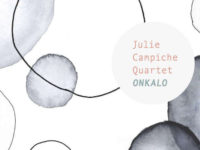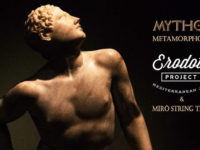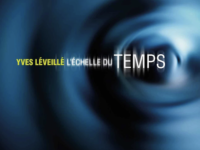There are few musicians who are collaborating with luminaries such as Michael Nyman, Bjork, Philip Glass, James Blake and Max Richter among others while still in their early 20s. There are also few artists who can play their first concert to a semi-packed, socially distanced concert hall after a six-month hiatus and deliver a performance which felt as if she had played without a break.
Jess Gillam is first a musician but secondly an entertainer. She engages and connects with her audience, and everyone appeared to be captivated at Snape Maltings. Reviewing Time was therefore something I was looking forward to.
In 2019, Jess Gillam became the youngest-ever presenter for BBC Radio 3. Her podcast “This Classical Life” has been nominated for a number of awards including a PRIX Europa in the Radio Music Programme category and the Prix Italia, and won a Gold Award as the Best Specialist Music Programme at the UK Audio and Radio Industry Awards. Her performance at the Last Night of the Proms in 2018 was described as “the indisputable highlight” by BBC News.
Her eclectic choice of classical and re-arranged popular music by artists from Kate Bush to Brian Eno and David Bowie brings not only classical music to a new audience but explores the compositional expertise behind some of our most popular artists, placing them alongside classical composers.
Curated to be experienced as a whole, Jess Gillam’s Time mirrors the arc of energy in a passing day and the constant orbit of our existence.
“Last year, I moved to London and quickly became acutely aware of the speed and intensity of life. Everything is in constant orbit: I am orbiting around the world as a musician. There’s the orbit of a day, of thoughts around the mind – and I noticed how many people are looking for a place to stop and reflect,” Gillam says.
“To me, music can be completely transformative and the experience of watching a live performance or sitting down to listen to an album is one of the only places in modern life where we can completely focus on what is happening before us with no distractions,” she adds. “There are no screens, no instant messaging, just a sense of direct communication. It’s something that requires patience but can be utterly life-affirming.”
It is the first time the Jess Gillam Ensemble, made up of musician friends, have played and recorded together: The tracks were also refined in the studio with the input of the ensemble, as well as the composers and arrangers themselves. The album was mixed and mastered remotely while in lockdown.
“Making this album was one of the best experiences of my life,” Jess Gillam confirms. “I was fortunate enough to record with an incredible group of musicians and close friends. The pieces grew and changed and were molded over a few days, and the feeling of collectivity, collaboration and concentration paired with a lot of laughter and smiling made for one of the most inspiring musical environments I’ve experienced.”
“Early Morning Melody” is beautiful and celebrates the dawn of a new day, the energy lifting lightly and the intensity increasing as re-awakening occurs. A pure and unadulterated soprano sax sings out, like a bird calling as it soars, creating a sense of new beginnings and hope. “In Dappled Light” is bubbly and effervescent, as the chord patterns provide a base over which the saxophone rises. The lovely four-note ripples create a sense of water and falling, as the piano’s right hand descends, in contrast to the sax which continues its whimsical journey upward, shifting between the chord patterns. The strings add texture, fusing the shade and light together.
“Suspirium” is romantic, yet also there is a pulling melancholy to the piece, as if an underlying truth is trying to surface but being suppressed. The strings perfectly add to the slight sense of anguish. As the piece progresses, the anguish is replaced by reassurance as the repeated motifs calm and soothe. “Truman Sleeps” opens with note sequences redolent of Beethoven’s “Moonlight Sonata,” and a circular motion of the sounds creates a sense of orbiting. The final third has a sense of being just a single step out of true, which is perfect for a number which is perhaps indicative of the uneven orbit of a day – the concept behind Time. Glass’ piece has been arranged beautifully by Simon Parkin, and the quickening pace in the final third adds a sense of eagerness to get on with the rest of the day.
“Bubble Gun” is a fun piece, maybe indicative of a light lunch, a little gentle flirtation perhaps and a walk in the park in the middle of a busy day. There is a continental feel and lilt to this. Great rhythms, a step up and down, some jazz rhythms just for the heck of it – and we are refreshed, having taken a little time out. Now, we are ready for the rest of the day. A lovely track with a delightful quirkiness centered on a delicate six-note melody, which attracts from the start and its magnetism is never lost. Standout.
Lyrical and narrative, “Where the Bee Dances” is a story within a story with several motifs which appear, disappear and reappear across the work like characters in a play. It’s sometimes serious, other times fun and deeply emotive. The energy is at times countered with a quietude, which can become menacing. Michael Nyman perfectly captures a changeable nature in his arrangements, especially when the cello part rises, the listener can imagine the activity of the insects of the title and the business and joyful return of the bees. The middle part has an urgency and fearfulness as the saxophone soars and screams across the top, in rallying cry. “Where the Bee Dances” finishes with running semiquavers and a huge build to the end, which Jess Gillam describes as “running water.”
“In Orbit,” by Will Gregory of Goldfrapp, has repeated six- and 12-note motifs which work as hypnotic, alluring charms. Gillam plays some of her best sax work and the slightly looser embouchure gives a soulful, emotive touch to her lower notes, which contrast and add texture and warmth to the piece. Gillam almost growls at times, and this is a superb piece with a touch of folk. The transfer of the original rhythmic pattern to the strings and back only adds more depths. The strong harmonic ending fits perfectly.
“Venus As a Boy” is a beautifully worked number with a quirkiness in the syncopated rhythms and a beautiful, life-giving fading and crescendo in the sound – created by adding instruments rather than fortissimo instructions. The upward flow of the strings to a point where the sax takes over is seamless. It is a joyfully wayward track which demonstrates John Metcalfe’s arrangement skills and the cleverness of the writing is a delight.
“On the Nature of Daylight” is slow, gentle and slightly dark with the slowing of the day, a contrast with the adventurous music of the earlier tracks signifying a cooling down, a change of light and the earth turning away from the sun to travel towards the night. If you have never heard viola and cello played emotively, this is a track to listen to. The sax offers a continuum into the upper registers and the interaction between strings and sax is a delight, emphasizing the singing, voice-like nature of the saxophone. The ending is breathy and gorgeous.
“Melody for Saxophone No. 10” is just that – a beautiful, soaring melody which the soprano sax is perfect for, soaring ethereally into the mists and taking the reader with it as its floats away. There is, in this arrangement, a respect and understanding of the range of the instrument. “Retrograde” is a beautiful, soaring excursion which sees the sax travel the registers in playful and airy mood with gorgeous backing from the strings and piano. Some powerfully emotive passages from Jess Gillam contrast wonderfully with the gentleness of the accompaniment.
“Transit of Venus” is smooth, slow and a perfect homage to the goddess of love, as she traverses her universe, held in check yet powerfully beautiful. The piano and sax converse in a six-note motif over which the sax sighs and the strings add delicate waves of texture to emphasize the delicate beauty of the piece. Brian Eno, Jon Hopkins and Leo Abraham’s “Emerald and Stone” closes Time in a celebration of the night. All is calming and peaceful. Colors drift in and out with sustained notes and clarity of pitch. Gillam says “there are endless possibilities with one single note and how to shape it,” and here she demonstrates how.
Time is escapist, engaging and mesmerizing in places. It is a journey of discovery, not only in Jess Gillam’s mastery of her instrument but also in re-worked compositions. There is a sense of finding the hidden depths in them. It is something to listen to with the concept in mind, the thoughts of a full day, all its parts and hidden delights, mood changes and each listen reveals the music anew.
This skilled musician is growing her own style and take on musical concepts. There is a strong sense, especially in the parts where she imbues emotions and strength, that there is more to come and we are still at the beginning of Gillam’s career. After seeing her play and understanding a little of her character and desire to connect with the listeners, Jess Gillam’s Time goes a long way to achieve that.
- Wabi Sabi – ‘The Love Insane’ (2024) - March 24, 2024
- James McGowan Ensemble – ‘Reaching In’ (2023) - December 10, 2023
- Defne Sahin – ‘Hope’ (2023) - November 19, 2023




